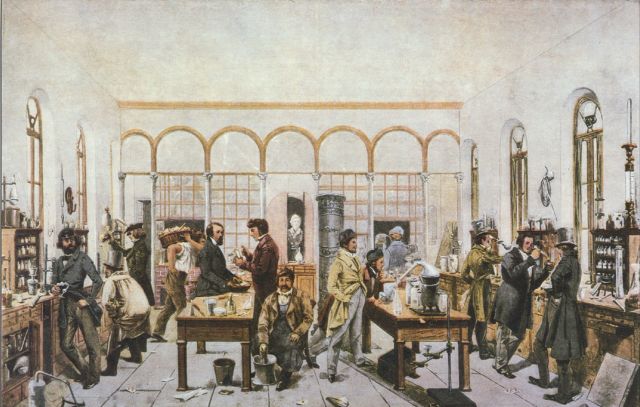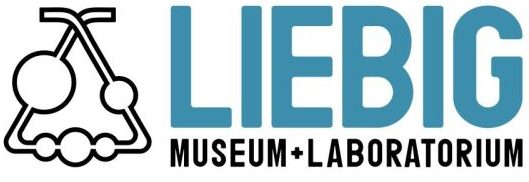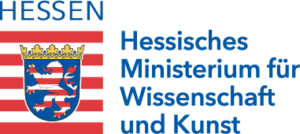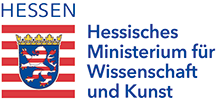Ein Auszug unserer Meldungen
- Zwei neue Publikationen anlässlich von 100 Jahren Liebigmuseum im Jahr 2020
- „Der Seltersberg zu Liebigs Zeit – eine topografische Spurensuche“ Vortrag von Dr. Werner Schmidt (2018)
- Gießener Chemie Lehramts-Studierende veröffentlichen Portrait über den Namensgeber der Universität (2018)
- Volksbank Mittelhessen und CURSOR AG spenden je 3000 Euro an das Liebig-Laboratorium (2017)
- Wirtschaftsverband PlasticsEurope Deutschland unterstützt das Liebig-Museum (2017)
- Volksbank Mittelhessen dreht im Liebig-Museum (2016)
Geschichte des Liebig-Laboratoriums in Gießen
Das Liebig-Laboratorium in der Nähe des Gießener Bahnhofs hat eine bewegte Vergangenheit hinter sich. Neben ruhmvollen Zeiten erlebte es Phasen totalen Niederganges bis hin zu Plänen, das ganze Gebäude abzureißen.
Wie es dazu kam, dass es heute an der Liebigstraße als Liebig-Museum wieder in neuem Glanz erstrahlt, soll im folgenden dargelegt werden.
Die Geschichte wird erzählt von Günther Klaus Judel.

There are no upcoming events at this time
§ 1 name
The association bears the name “Justus Liebig-Gesellschaft zu Gießen e. V. „. It is based in Giessen.
The association is entered in the register of associations at the district court of Gießen
§ 2 tasks
- Qualified and generally understandable presentation of Liebig’s life’s work, in particular its importance for the development of modern chemistry and human society.
- Preservation and care of the original Liebig laboratory – today’s Liebig Museum – with its historical furnishings and collection.
- Promotion of chemical-historical research through scientific processing of Liebig’s writings and his correspondence.
- Museum tours, lectures and exhibitions.
§ 3 non-profit status
- The association pursues exclusively and directly charitable purposes in the sense of the section „tax-privileged purposes“ of the tax code, in particular by promoting science and research as well as general education.
- The association’s funds may only be used for statutory purposes. The members do not receive payments from the association. No person may benefit from disproportionately high remuneration.
- The board of directors basically exercises its office on a voluntary basis. The payment of lump-sum expense allowances and other remuneration to members of the board or other members of the association is permitted.
§ 4 Membership
- Association members can become:
- natural persons as individual members.
- legal persons as corporate members.
- Membership is requested in writing. The board of directors decides on the application for membership.
- A natural person who has made a special contribution to the work and the goals of the association can be appointed an honorary member by resolution of the board.
- Membership ends:
- by the death of the member (for natural persons),
- through dissolution (in the case of legal persons),
- by leaving,
- by exclusion.
- Membership can be terminated in writing to the board at the end of the year.
- An exclusion can take place
- if the member is more than two years in arrears with the membership fee,
- if there is behavior that is harmful to the association.
The board decides on the exclusion.
§ 5 Rights and duties of the members
- Membership entitles
- for participation and voting at the general assembly
- to submit applications,
- free entry to the museum,
- for free use of the museum’s holdings for scientific purposes, film work, etc.
- The members are obliged to pay the annual fee. Honorary membership is free of charge. Corporate members pay five times the annual fee set for individual members. In individual cases, the board of directors can make special regulations regarding the obligation and payment of contributions. In the event of arrears, the member’s voting rights are suspended.
§ 6 organs
Organs of the association are:
- the general assembly,
- the board,
- the advisory board.
§ 7 General Assembly
- The ordinary general assembly takes place once a year. Extraordinary general meetings are called,
- if the board so decides,
- if it is requested in writing by at least 20% of the members stating the reason.
The invitation to the general meeting takes place in writing at least 14 days in advance, stating the agenda by the board.
Minutes are to be drawn up that reflect the resolutions and are to be signed by the chairman of the meeting and the secretary. - The general meeting
- receives the annual report, the accounts report and the auditors‘ report,
- decides on the discharge of the board,
- elects the board of directors every 2nd year and two auditors every year – re-election is possible -,
- sets the annual fee,
- decides on requests from members that have been submitted to the board in writing no later than 8 days before the date of the meeting,
- decides to dissolve the association.
- Only members who are present are entitled to vote. The general assembly decides with a majority of the yes and no votes cast.
Abstentions are not counted.
For resolutions on changing the statutes, three-quarters of the members present must vote in favor. To dissolve the association, three-quarters of all members must vote in favor. In this case, a written vote is possible. - Changes to the statutes, which must be made at the request of the registry court or the tax office, can be decided by the board and must be announced to the members at the general meeting.
§ 8 Board of Directors
- The board consists of:
- the 1st chairman,
- the 2nd chairman,
- the treasurer,
- the curator,
- the archivist,
- the secretary,
- and up to four assessors.
- The board of directors conducts the business. It has a quorum if at least half of its members are present. In a tie vote, the chairman decides.
- The first chairman calls the board meeting at least once a year. The meeting is convened in writing with a 14-day notice period, stating the agenda. In individual cases, resolutions of the board of directors can also be passed by circulation. Resolutions passed by circulation are to be recorded in the minutes of the next board meeting.
- The association is represented in and out of court by the 1st chairman and the 2nd chairman. Each of them has sole power of representation.
§ 9 Advisory Board
The advisory board advises the board of directors. Permanent members of the advisory board are:
- the Minister of Science of the State of Hesse,
- the Lord Mayor of the City of Giessen,
- the President of the Justus Liebig University Giessen, whose membership on the advisory board is not tied to membership in the society.
In addition, the board of directors can appoint up to three other people to the advisory board for a period of two years.
§ 10 Resolutions
Resolutions of the association’s organs are put down in writing and signed by the chairman of the meeting and the secretary.
§ 11 financial year
The financial year is the calendar year.
§ 12 Dissolution of the Association
If the company is dissolved or tax-privileged purposes no longer apply, the company’s assets – after deducting any liabilities that may still exist – are transferred to a legal entity under public law or another tax-privileged corporation for the purpose of use for science and culture.
Registered at the register court Gießen (VR 749, case 3) on July 17th, 2014
Erhalt der Bausubstanz durch Spenden
Um die historische Bausubstanz zu erhalten, sind große finanzielle Anstrengungen notwendig, die durch die Justus Liebig-Gesellschaft zu Giessen e.V. aufgrund von Beiträgen und Spenden erbracht werden. In Würdigung dieser Anstrengungen wurde das Museum in das Programm „Historische Stätten der Chemie“ aufgenommen. Die Gesellschaft Deutscher Chemiker (GDCh) würdigt so Leistungen von geschichtlichem Rang in der Chemie. Als Orte der Erinnerung werden Wirkungsstätten beteiligter Wissenschaftler und Wissenschaftlerinnen in einem feierlichen Akt ausgezeichnet. Dementsprechend wurde am 16. Mai 2003 eine Gedenktafel angebracht.
Zu diesem Anlass erschien eine Broschüre, die Liebigs wissenschaftliches Werk und die Tragweite seiner Arbeiten im aktuellen Kontext darstellt. Diese Broschüre beschreibt nun das Museum ganz besonders gut. Sie kann im Museumsshop bezogen werden.
M – Das Entdeckermagazin der Merck KGaA hat 2012 den Film „Fenster in die Geschichte der Chemie“ veröffentlicht, den wir hier mit Erlaubnis der Urheber gerne zeigen:




